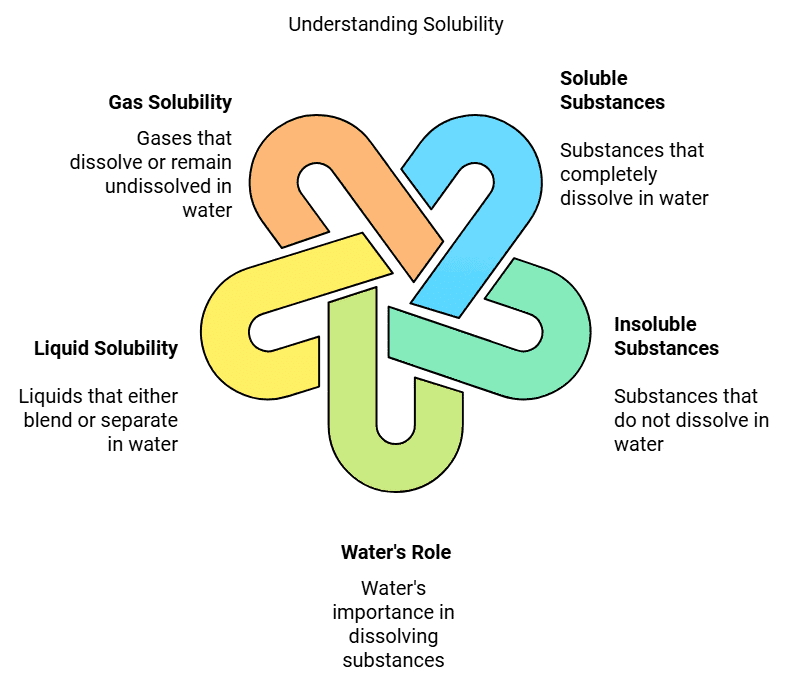Materials Around Us Chapter Notes | Science Class 6 PDF Download
Introduction
Have you ever wondered what the world around you is made of?
Imagine if your chair were made of jelly or your water bottle was made of paper—how funny would that be?
Everything we see, touch, and use is made from different kinds of materials. The spoon you eat with, the clothes you wear, and even your school bag are made of special materials chosen for a reason. Some materials are hard, like metal, while others are soft, like cotton. Some can bend, like rubber, while others, like glass, are stiff and break easily. Learning about materials helps us understand why things are made the way they are—like why windows are made of glass and not wood!
Let’s dive in and explore the amazing world of materials!

Observing Objects Around Us
- Our food, clothing, and other daily objects display a wide range of variety.
- Objects surrounding us include chairs, bullock carts, cycles, kitchen utensils, books, clothes, toys, water, stones, and more.
- These objects vary in shape, color, and purpose.
- Some objects are round in shape, such as rubber balls, footballs, and glass marbles.
- Other objects, while not perfectly round, resemble a round shape, like apples, oranges, and earthen pitchers.

- We can categorize objects based on different criteria, such as the material they are made of.
- For example, we can group objects made of plastic together, including buckets, lunch boxes, toys, water containers, and pipes.
- Objects can be grouped in numerous ways, either by their shape or the materials they are made of.
- All objects are made of one or more materials, such as glass, metal, plastics, wood, or cotton.

The Early Pottery in India
- The oldest pottery discovered in the Indian subcontinent is thought to be around 7,000 to 8,000 years old, found in areas like the Ganga plains (specifically Lahuradewa) and Baluchistan (especially Mehrgarh).
- From about 4000 BCE onwards, the Sindhu-Sarasvati culture developed methods for producing wheel-turned pottery, including the use of coloured coatings (known as 'slips'), decorative painting, and more.
- These methods became even more refined during the Sindhu-Sarasvati (or 'Harappan') Civilization (2600-1900 BCE), featuring bright red surfaces with black designs that displayed geometric patterns and images of animals.
- The clay used for crafting pots, dishes, bowls, and other items was carefully chosen, cleaned, sieved, kneaded, shaped on a wheel, and then baked in kilns (the baked clay is termed 'terracotta').
- Pots were used for various functions, including cooking and storing food like grains, oil, and ghee. Some large storage jars and other pottery pieces can be viewed at the National Museum in New Delhi.
How to Group Materials?
Grouping objects helps us understand them better. By using various materials, we can create objects that serve similar purposes. This process of grouping highlights the similarities and differences between objects.

Let’s Discuss Classification of Materials
- Objects can be made from various materials, and some materials can create multiple objects.
- The process of sorting objects into groups is called classification, based on common properties they share.
- Objects may consist of a single material or a mix of different ones.
- Similarly, materials can be classified by specific properties, such as their appearance (e.g., lustrous or non-lustrous) and texture (e.g., hard or soft).
- Materials have different properties that influence their usage.
Examples of Grouping
- Shape: Round (ball), square (box), cylindrical (tube).
- Colour: Red (apple), blue (sky), green (leaf).
- Hardness: Soft materials can be compressed or scratched easily, while hard materials are not.
- Softness: Soft (rubber), hard (metal).
- Shine: Materials with shiny surfaces are described as lustrous, commonly seen in metals.
What are the Different Properties of Materials?
1. Observe and Identify Appearance of Materials

Materials can look very different. For instance, freshly cut unpolished wood appears different from iron. Iron, copper, and aluminium have distinct appearances but share some similarities that differentiate them from wood.
Lustrous vs. Non-Lustrous Materials
- Lustrous materials are shiny and mostly metals like iron, copper, zinc, aluminium, and gold. Some metals can lose their shine and appear dull due to air and moisture.
- Non-lustrous materials do not have shiny surfaces, including paper, wood, rubber, and jute.
Are all lustrous materials metals?
- Not all shiny materials are metals. The saying "All that glitters is not gold" reflects this.
- Some materials get their shine from polishing or thin coatings of plastic, wax, or other substances, and these may not be metals.
2. Which materials are hard?

- Different materials have different levels of compressibility and scratch resistance.
- Some materials, like wood, aluminium, stone, nails, candles, chalk, etc., can be easily scratched with a metal key.
- Other materials are more difficult to scratch. Materials that can be easily compressed or scratched are considered soft, while those that are difficult to compress are considered hard.
- For instance, rubber is tougher than sponge but softer than iron, indicating that hardness and softness can shift based on the comparison.
3. Explore materials through which one can see or cannot see


Pranav, Shreya, and Sanya are playing hide and seek! Pranav hides behind a solid wall, Shreya behind a big tree, and Sanya behind a frosted glass door. Meanwhile, Shreya’s younger brother is watching them through a glass window. But wait! Why can he see some things clearly and not others? This happens because different materials let light pass through in different ways! Let’s explore:
- Transparent Materials: These are materials through which we can see objects clearly. Examples: glass, water, air, and cellophane paper.
- Opaque Materials: These materials do not allow light to pass through. Examples: wood, cardboard, and metals.
- Translucent Materials: These allow some light to pass but do not give a clear view of what’s on the other side. Examples: butter paper and frosted glass.

4. What is soluble in water, what is not?

When we mix materials in water, some, like sugar and salt, completely vanish because they dissolve. We say these materials are soluble in water. Meanwhile, some materials do not mix with water and remain visible even after stirring for a long time. These materials are insoluble in water. This shows that not all materials act the same way in water!

Let’s Discuss Soluble and Insoluble Materials:
- Certain substances completely dissolve or vanish in water, making them soluble in water.
- There are substances that do not blend with water, remaining undissolved even after extensive stirring. These substances are insoluble in water.
- Water is crucial for our bodily functions due to its ability to dissolve numerous substances.
- It is observed that some liquids fully blend with water, while others do not and separate when left undisturbed for a while.
- Some gases are soluble in water, while others are not. Oxygen gas dissolved in water, for instance, is vital for aquatic animals and plants.
 Mixing of Liquids and Solubility of Gases in Water
Mixing of Liquids and Solubility of Gases in Water

- Some liquids mix well with water and become part of it, like sugar in water.
- Other liquids do not mix with water and form a separate layer, such as oil. When still, oil floats on top of water because it is less dense.
- Just like liquids, some gases can dissolve in water, while others cannot.
- For example, oxygen gas dissolves in water and is vital for the survival of fish and other aquatic animals. Plants in water also need dissolved oxygen for respiration.
5. How heavy or light?

- Mass helps us figure out if something is heavy or light.
- When we say an object is heavier, it means it has more mass. Conversely, if an object is lighter, it has less mass.
6. Space and Volume

- Volume is the space taken up by an object.
- We usually measure the volume of liquids in litres (L) or millilitres (mL).
What is Matter?

- Anything that occupies space and has weight is called matter.
- All materials have two main properties: mass and volume.
- Examples of matter include water, sand, pebbles, and a cup.
- The amount of matter in an object is referred to as its mass, measured in grams (g) or kilograms (kg).
- The space that matter takes up is its volume, measured in litres (L) or millilitres (mL).
Classifying Materials

- Materials can be grouped by their similarities and differences. For instance, metals like iron, copper, and aluminium are grouped together because they are metals.
- Humans classify not just objects, but also rocks, plants, and animals.
- This grouping helps identify patterns in their properties. For example, metals are typically shiny, strong, and good conductors of heat and electricity.
Unit of Mass: Kilogram (kg)
- The kilogram (kg) is the standard unit of mass in the International System of Units (SI).
- When writing it, ensure there is no space between "k" and "g," and no full stop after "kg," unless at the end of a sentence.
- For example: 7 kg (not 7 kgs).
Units of Volume: Litre, Millilitre, and Cubic Metre
- The litre is denoted by a capital "L" (L), while the millilitre is written as "mL," with a lowercase "m" and an uppercase "L."
- For example: 500 mL (not 500 ml).
- The SI unit for volume is the cubic metre, abbreviated as m3, which is written with a superscript "3" to indicate it is cubic.
- For example: 2 m3 (not 2 m3).
- Always leave a space between the number and the unit when writing these units.
- Note: 1 m3 equals 1000 litres (L).
Weight vs. Mass
In everyday language, weight is often used to mean mass, as it is determined by weighing. Recognising this difference is important for understanding these two concepts.
 |
Download the notes
Chapter Notes: Materials Around Us
|
Download as PDF |
Ayurveda and the 20 Properties
Overview of Ayurveda's Property Classification

In ancient India, there was a system for classifying things based on their qualities. Ayurveda, a traditional Indian medical system, groups elements according to their properties. An important text in Ayurveda, the Ashtanga Hridaya, outlines 20 properties (guna), which consist of ten pairs of opposite qualities, applicable to all physical matter, living beings (like plants, animals, and humans), the environment, and even food.
Grasping these properties is essential in Ayurveda as they aid in diagnosing and treating health issues by identifying the qualities of various substances and their impacts on the body.
Key Concepts
- Variety of Materials: Items can be made from one or several materials.
- Classification Methods: Categorising based on characteristics like appearance (shiny or dull), texture (hard or soft), and transparency (clear, semi-clear, opaque).
- Properties of Materials: Influence their application and behaviour.
- Concept of Matter: Anything that takes up space and has weight is known as matter. The space that matter occupies is called volume, while mass measures how much matter is in an object.
|
100 videos|261 docs|49 tests
|
FAQs on Materials Around Us Chapter Notes - Science Class 6
| 1. What are the different types of early pottery found in India? |  |
| 2. How can we group materials based on their properties? |  |
| 3. What is the definition of matter in scientific terms? |  |
| 4. What are the 20 properties mentioned in Ayurveda related to materials? |  |
| 5. Why is it important to observe objects around us in learning about materials? |  |





























